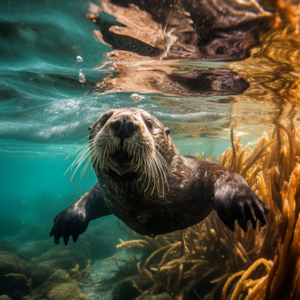Sea otters are fascinating creatures that inhabit coastal waters and are known for their playful behavior and adorable appearance. However, many people wonder if sea otters bite and if they pose a threat to humans or other animals. In this article, we will explore the topic of sea otter bites, their behavior, and their interactions with humans and other species. We will delve into the reasons why sea otters may bite, the circumstances in which they are most likely to bite, and how to stay safe when encountering these charismatic marine mammals. So, let’s dive in and discover the truth about sea otters and their biting habits.
Key Takeaways
- Sea otters have the ability to bite and can deliver powerful bites.
- Biting behavior in sea otters is usually defensive or territorial.
- It is important to maintain a safe distance and not disturb sea otters to avoid potential bites.
- If bitten by a sea otter, seek medical attention as their bites can cause serious infections.
Understanding Sea Otters: An Overview
Sea otters are fascinating marine mammals known for their playful nature and adorable appearance. In this section, we will provide a brief description of sea otters, explore their natural habitat, and delve into their behavioral traits.
A. Sea Otters: A Brief Description
Sea otters, scientifically known as Enhydra lutris, are the largest members of the weasel family. They have a distinct appearance with dense, waterproof fur that keeps them warm in the cold waters they inhabit. These furry creatures have a streamlined body, webbed feet, and a flat tail, which they use as a rudder while swimming.
Sea otters have a unique dental adaptation that sets them apart from other marine mammals. They possess sharp, strong teeth designed for crushing and breaking open shells of their prey, such as clams, mussels, and sea urchins. This specialized dentition allows them to extract the nutritious meat inside the shells.

B. The Natural Habitat of Sea Otters
Sea otters are primarily found along the coasts of the northern Pacific Ocean, from Alaska to California, and across to Russia and Japan. They inhabit nearshore marine environments, including rocky shores, kelp forests, estuaries, and coastal bays. These areas provide them with an abundant food supply and shelter from predators.
Kelp forests, in particular, are crucial habitats for sea otters. The dense kelp provides them with protection from strong currents and predators, as well as a source of food. Sea otters are known to wrap themselves in kelp strands to anchor themselves while resting or feeding, preventing them from drifting away.
C. Sea Otters’ Behavioral Traits
Sea otters are highly social animals, often found in groups called rafts. These rafts can consist of a few individuals to hundreds of otters, depending on the availability of resources and the population density in a particular area. They communicate with each other using a variety of vocalizations, including whistles, chirps, and growls.
One of the most endearing traits of sea otters is their playful behavior. They can often be seen rolling, diving, and engaging in acrobatic feats in the water. Play serves multiple purposes for sea otters, including strengthening social bonds, practicing hunting techniques, and simply having fun.
While sea otters are generally docile creatures, it is important to note that they are wild animals and should be treated with caution and respect. In rare cases, sea otters may exhibit aggressive behavior, including biting. However, such incidents are infrequent and usually occur when otters feel threatened or cornered.
It is crucial to remember that sea otters are a protected species, and it is illegal to approach, touch, or disturb them in their natural habitat. Interactions with humans can disrupt their natural behavior and potentially harm both the otters and humans involved.
In conclusion, sea otters are fascinating creatures with unique characteristics and behaviors. Understanding their natural habitat and behavioral traits is essential for ensuring their conservation and coexistence with humans. By respecting their space and appreciating them from a distance, we can help protect these remarkable marine mammals for future generations to enjoy.

Do Sea Otters Bite: Unraveling the Truth
Sea otters are fascinating creatures that inhabit coastal waters and are known for their playful behavior and adorable appearance. However, like any wild animal, sea otters have the potential to bite. In this section, we will explore instances of sea otters biting, the circumstances that may lead to such behavior, and the severity of sea otter bites.
A. Instances of Sea Otters Biting
While sea otters are generally not aggressive towards humans, there have been rare instances where they have bitten people. These incidents are often a result of human interaction with wild otters, such as approaching them too closely or attempting to touch them. It is important to remember that sea otters are wild animals and should be observed from a safe distance.
B. Circumstances Leading to Sea Otters Biting
Sea otters may bite when they feel threatened or cornered. They have sharp teeth that they use for cracking open shells and feeding on their prey, so it is natural for them to defend themselves if they perceive a threat. It is crucial to respect their space and avoid any actions that may provoke defensive behavior.
Furthermore, sea otters are protective of their young, and a mother otter may bite if she feels her pups are in danger. It is essential to give them the space they need to care for their offspring without interference.
C. The Severity of Sea Otter Bites
Sea otters have strong jaws and sharp teeth that can cause injury if they bite. While their bites are not typically life-threatening, they can be painful and may require medical attention. It is crucial to seek medical help if bitten by a sea otter to prevent infection and ensure proper treatment.
It is worth noting that sea otters are a protected species, and it is illegal to harm or harass them in any way. Interacting with sea otters should always be done with caution and respect for their natural behavior.
In conclusion, while sea otters generally do not bite humans, there have been rare instances where bites have occurred. These incidents are often a result of human interference or the otters feeling threatened. It is important to maintain a safe distance from these wild animals and observe them from afar. By respecting their space and behavior, we can coexist with these fascinating creatures without causing harm to either party.
Do Sea Otters Attack Humans: A Closer Look
Sea otters are adorable marine mammals known for their playful behavior and their affinity for water. However, there have been recorded cases of sea otters attacking humans, which raises the question: do sea otters pose a threat to our safety? In this section, we will delve into the topic and explore the reasons behind sea otter attacks, as well as preventive measures to avoid such incidents.
A. Recorded Cases of Sea Otters Attacking Humans
While sea otter attacks on humans are relatively rare, there have been a few documented cases over the years. One such incident occurred in California, where a woman was bitten by a sea otter while swimming. Another incident involved a kayaker who was bitten on the hand by a sea otter in Alaska. These incidents, although isolated, highlight the importance of understanding sea otter behavior and taking precautions when interacting with them.
B. Reasons Behind Sea Otters Attacking Humans
Sea otters are generally not aggressive towards humans, but there are several factors that can contribute to their aggression. One possible reason is that sea otters, like any wild animal, may feel threatened or cornered when approached too closely. They have sharp teeth and strong jaws, which they use primarily for cracking open shells to access their prey. In rare cases, if they feel threatened or provoked, they may bite as a defensive mechanism.
Another factor that may contribute to sea otter attacks is human interaction. When sea otters become accustomed to human presence, they may lose their natural fear of humans and become more comfortable approaching them. This can lead to situations where sea otters may bite or act aggressively if they feel their space is being invaded or if they are seeking food.
C. Preventive Measures to Avoid Sea Otter Attacks
To minimize the risk of sea otter attacks, it is important to follow certain preventive measures when encountering these animals in their natural habitat:
- Maintain a safe distance: Always keep a safe distance from sea otters and avoid approaching them too closely. This will help prevent any potential feelings of threat or aggression.
- Do not feed sea otters: Feeding wild animals disrupts their natural behavior and can lead to dependency on humans for food. It is essential to refrain from feeding sea otters, as this can encourage them to approach humans in search of food, increasing the risk of aggression.
- Respect their space: Sea otters need their personal space, just like any other wild animal. Avoid encroaching on their territory or disturbing their resting areas. Give them the respect and space they deserve.
- Educate yourself: Learn about sea otter behavior, their habitat, and their characteristics. Understanding their natural instincts and tendencies can help you make informed decisions and minimize the chances of any negative interactions.
By following these preventive measures, you can ensure a safe and enjoyable experience when encountering sea otters in the wild. Remember, sea otters are fascinating creatures that play a vital role in marine ecosystems, and it is our responsibility to respect their natural behavior and protect their well-being.

Do Pet Otters Bite: The Reality
A. The Possibility of Pet Otters Biting
When it comes to owning a pet otter, one of the concerns that potential owners may have is whether or not these adorable creatures bite. While pet otters can be playful and affectionate, it is important to understand that biting is a natural behavior for them.
Sea otters, in particular, have sharp teeth that they use for various purposes, including cracking open shells to access their favorite food, such as clams and mussels. These teeth can also be used as a defense mechanism when they feel threatened or scared.
It is crucial to remember that even though pet otters may be domesticated, they still retain their wild instincts. This means that they may bite if they feel provoked or if they are not properly trained and socialized. It is essential to be aware of this possibility and take appropriate measures to prevent any potential incidents.
B. Factors Influencing Pet Otters to Bite
Several factors can influence a pet otter’s likelihood to bite. Understanding these factors can help owners create a safe and secure environment for their furry friends. Here are some key factors to consider:
- Lack of socialization: Otters that have not been adequately socialized from a young age may be more prone to biting. Socialization helps otters become comfortable around humans and other animals, reducing their fear and aggression.
- Fear or stress: Like any animal, otters may bite when they feel threatened or stressed. It is essential to create a calm and secure environment for your pet otter to minimize these triggers.
- Protecting territory or resources: Otters are territorial animals, and they may bite if they feel their space or belongings are being invaded. Providing them with their own designated areas and toys can help prevent territorial aggression.
- Health issues: If an otter is in pain or discomfort due to an underlying health issue, it may resort to biting as a way to communicate its distress. Regular veterinary check-ups and prompt treatment of any health problems can help prevent this.
C. How to Handle Pet Otters to Prevent Biting
Preventing biting incidents with pet otters requires responsible ownership and proper handling techniques. Here are some tips to help you handle your pet otter safely:
- Start with a reputable breeder: When getting a pet otter, it is crucial to choose a reputable breeder who prioritizes proper socialization and handling from an early age. This will increase the chances of your otter being well-adjusted and less likely to bite.
- Provide proper training: Training your pet otter using positive reinforcement techniques can help establish boundaries and teach them appropriate behavior. Rewarding good behavior and redirecting unwanted behavior can go a long way in preventing biting incidents.
- Avoid rough play: While otters can be playful, it is important to avoid rough play that may encourage biting. Use toys and interactive games that promote mental stimulation and physical exercise without encouraging aggressive behavior.
- Respect their boundaries: Just like humans, otters have their own personal space and boundaries. It is important to respect these boundaries and avoid forcing interactions when your otter is not comfortable. This will help build trust and reduce the likelihood of biting.
- Supervise interactions: Whenever your pet otter interacts with other animals or unfamiliar humans, it is crucial to supervise these interactions closely. This will allow you to intervene if any signs of aggression or discomfort arise, preventing potential biting incidents.
By understanding the possibility of pet otters biting, the factors that influence their behavior, and how to handle them properly, owners can create a safe and enjoyable environment for their furry companions. Responsible ownership and proper training are key to preventing biting incidents and fostering a strong bond with your pet otter.
Can Sea Otters be Pets: A Comprehensive Analysis
A. The Legality and Feasibility of Keeping Sea Otters as Pets
Keeping sea otters as pets may seem like an appealing idea to some people, given their adorable appearance and playful nature. However, before considering the possibility of having a sea otter as a pet, it is important to understand the legal and practical aspects involved.
Legal Considerations
In most countries, it is illegal to keep sea otters as pets. These marine mammals are protected under various laws and regulations due to their endangered status. The Marine Mammal Protection Act in the United States, for example, strictly prohibits the capture, harassment, or possession of sea otters without proper permits.
Feasibility and Ethical Concerns
Even if it were legal to keep sea otters as pets, it is important to consider the feasibility and ethical implications of doing so. Sea otters have specific dietary and habitat requirements that are challenging to replicate in a domestic setting. They are highly specialized marine animals that rely on a diet of shellfish, such as clams, crabs, and sea urchins, which may be difficult to provide in captivity.
Sea otters are also highly social animals that live in close-knit family groups called rafts. They engage in complex behaviors and have specific social and physical needs that may not be met in a home environment. Keeping them in captivity could lead to stress, behavioral issues, and a reduced quality of life.
B. The Challenges of Keeping Sea Otters as Pets
While the idea of having a sea otter as a pet may seem appealing, it is essential to understand and consider the challenges associated with their care and maintenance.
Specialized Diet and Feeding Requirements
Sea otters have a unique diet that consists mainly of shellfish. Providing them with a proper diet in captivity can be challenging and expensive. It requires access to a constant supply of live shellfish, which may not be readily available or affordable for most individuals.
Space and Habitat Needs
Sea otters are highly active animals that require a large amount of space to swim, dive, and play. They are adapted to living in coastal habitats, where they spend a significant amount of time in the water. Replicating this environment in a home setting is practically impossible and would not provide the necessary space for the otter to thrive.
Health and Veterinary Care
Sea otters are susceptible to various health issues, including infections, parasites, and diseases. Providing proper veterinary care for a sea otter can be challenging, as their specialized needs may require access to specialized marine mammal veterinarians and facilities. This can be both costly and logistically difficult for most individuals.
C. The Pros and Cons of Keeping Sea Otters as Pets
While the idea of having a sea otter as a pet may be appealing to some, it is essential to weigh the pros and cons before considering such a decision.
Pros of Keeping Sea Otters as Pets
- Unique and fascinating companions: Sea otters are incredibly intelligent and social animals, making them fascinating companions for those who have the means to care for them properly.
- Educational opportunities: Having a sea otter as a pet can provide educational opportunities for individuals and communities to learn more about these remarkable marine mammals and their conservation needs.
Cons of Keeping Sea Otters as Pets
- Legal restrictions: The legality of keeping sea otters as pets is a significant barrier, as they are protected under various laws and regulations due to their endangered status.
- Ethical concerns: Keeping sea otters in captivity may not meet their complex physical, social, and behavioral needs, leading to stress and a reduced quality of life.
- Feasibility and cost: Providing the necessary diet, habitat, and veterinary care for a sea otter can be challenging, expensive, and logistically difficult for most individuals.
In conclusion, while the idea of having a sea otter as a pet may be appealing, it is important to consider the legal, ethical, and practical aspects involved. Sea otters are highly specialized marine mammals that require specific care, habitat, and diet. Keeping them in captivity may not be feasible or in their best interest. Instead, it is crucial to support conservation efforts and admire these remarkable creatures in their natural habitats.
Are Sea Otters Aggressive: An In-depth Study
A. Understanding the Aggressive Nature of Sea Otters
Sea otters are known for their playful and adorable appearance, but beneath their charming exterior lies a complex set of behaviors, including occasional aggression. Understanding the factors that contribute to sea otter aggression is crucial for both researchers and individuals who interact with these marine mammals.
Sea otters are generally not aggressive towards humans, but they can display aggressive behaviors towards each other, especially during mating season or when defending their territory. These behaviors can include biting, scratching, and vocalizing. It’s important to note that sea otters primarily exhibit aggression as a means of self-defense or protecting their young.
B. Factors Contributing to Sea Otter Aggression
Several factors can contribute to sea otter aggression. One of the primary factors is the natural instinct for self-preservation. Sea otters, like any other animal, have a strong survival instinct, and when they feel threatened or cornered, they may resort to aggressive behaviors to protect themselves.
Another factor that can contribute to sea otter aggression is territoriality. Sea otters establish territories, and when another otter enters their space, conflicts can arise. These territorial disputes can lead to aggressive encounters, including biting and physical confrontations.
Mating season is another time when sea otters can display heightened aggression. During this period, male otters compete for the attention of females, leading to aggressive behaviors such as biting and chasing. This aggression is primarily directed towards other male otters rather than humans.

C. Ways to Deal with Aggressive Sea Otters
If you find yourself in a situation where you encounter an aggressive sea otter, it’s important to remember that they are wild animals and should be treated with caution. Here are some guidelines to help you deal with aggressive sea otters:
- Maintain a safe distance: When encountering a sea otter, it’s crucial to keep a safe distance to avoid provoking any aggressive behavior. Respect their space and observe them from afar.
- Avoid approaching sea otters: Sea otters may perceive human interaction as a threat, so it’s best to avoid approaching them, especially if they are displaying signs of aggression.
- Do not feed sea otters: Feeding sea otters can disrupt their natural behavior and may lead to increased aggression. It’s important to let them forage for their own food in their natural habitat.
- Report aggressive behavior: If you witness an aggressive sea otter or have an encounter that raises concerns, it’s essential to report it to the appropriate authorities or local wildlife organizations. They can provide guidance and take necessary action if needed.
In conclusion, while sea otters can display aggression, it is primarily directed towards other otters or during specific circumstances such as mating season or territorial disputes. Understanding their behavior and following guidelines for safe interaction can help ensure both human and otter safety. Remember, appreciating these fascinating creatures from a distance is the best way to enjoy their presence without causing harm to them or yourself.
What Do Sea Otters Do at Night: A Glimpse into their Nocturnal Life
Sea otters, known for their playful and charismatic nature, have a fascinating nocturnal life. While they are primarily active during the day, sea otters also engage in various activities at night. In this section, we will explore the nighttime behaviors of sea otters and how these behaviors can influence their biting tendencies.
A. The Nighttime Activities of Sea Otters
Sea otters are highly active creatures, and their nighttime activities are no exception. Here are some of the things sea otters do at night:
- Foraging: Sea otters are voracious eaters, and they spend a significant portion of their nights searching for food. They have a diverse diet that includes shellfish, sea urchins, crabs, and other marine invertebrates. Using their dexterous paws, sea otters dive underwater to hunt for their prey, often using rocks as tools to crack open shells.
- Resting and Grooming: Like humans, sea otters need their beauty sleep. They often find a safe spot, such as kelp forests or rocky outcrops, to rest during the night. During these periods of rest, sea otters engage in extensive grooming to keep their fur clean and well-maintained. Grooming is essential for sea otters as it helps to insulate their bodies and maintain buoyancy in the water.
- Socializing: Sea otters are social animals, and they often gather in groups called rafts. These rafts provide safety and companionship, especially during the night when predators may be more active. Socializing within the raft involves playful interactions, vocalizations, and even holding hands to prevent drifting apart.
- Reproduction: Breeding season for sea otters typically occurs in the spring, but mating can also take place at night. Male sea otters may engage in aggressive behaviors during this time, including biting, as they compete for the attention of females. These nighttime encounters can be intense, with males vying for dominance and the opportunity to mate.
B. How Nighttime Behavior Influences Sea Otter Biting
Sea otters are generally not aggressive towards humans or other animals unless they feel threatened or provoked. However, understanding their nighttime behavior can shed light on the factors that may influence sea otter biting incidents. Here are a few key points to consider:
- Defense Mechanisms: Sea otters have several defense mechanisms to protect themselves from potential threats. If they feel threatened, they may exhibit defensive behaviors, including biting. It is important to respect their space and observe them from a safe distance to avoid any potential conflicts.
- Interaction with Humans: While sea otters are wild animals, they can occasionally interact with humans, especially in areas where human activities overlap with their habitats. It is crucial to remember that sea otters are protected by laws and regulations, and it is illegal to approach, touch, or feed them. Respecting their boundaries is essential for their safety and well-being.
- Environmental Factors: The behavior of sea otters, including their biting tendencies, can be influenced by various environmental factors. For example, changes in food availability or habitat degradation can impact their stress levels and potentially increase the likelihood of defensive behaviors.
In conclusion, sea otters engage in a range of activities at night, including foraging, resting, socializing, and reproduction. While sea otters generally do not bite unless provoked, understanding their nighttime behaviors and respecting their boundaries is crucial for coexisting peacefully with these remarkable marine mammals. By appreciating their natural behaviors and taking steps to protect their habitats, we can ensure the continued survival and well-being of sea otters for generations to come.
Conclusion
In conclusion, sea otters are adorable creatures that play a vital role in maintaining the health of marine ecosystems. While they are generally docile and non-aggressive, it is important to remember that they are wild animals and can bite if they feel threatened or provoked. It is crucial to respect their space and observe them from a safe distance to avoid any potential harm. If you ever have the opportunity to encounter these fascinating creatures in the wild, remember to admire them from afar and appreciate their important role in our oceans.
Frequently Asked Questions
Do sea otters bite humans?
While sea otters are generally not aggressive towards humans, they may bite if they feel threatened or cornered. It’s important to remember that they are wild animals with sharp teeth and a strong bite force. Therefore, it’s always best to observe them from a safe distance.
Do pet otters bite?
Yes, pet otters can bite. Despite their cute appearance, otters are wild animals and their behavior can be unpredictable. They have sharp teeth and a strong bite force, which they use as a defense mechanism. Therefore, it’s not recommended to keep otters as pets.
Do sea otters attack humans?
Attacks on humans by sea otters are rare but they can occur, especially if the otter feels threatened. Sea otters are wild animals and their behavior can be unpredictable. It’s always best to observe them from a safe distance and avoid any direct interaction.
What do sea otters do at night?
Sea otters are mostly nocturnal animals. At night, they are usually active, foraging for food, grooming their fur, and engaging in social behaviors. They have a diverse diet, which includes sea urchins, crabs, clams, and fish.
Can sea otters be pets?
No, sea otters cannot be kept as pets. They are wild animals with specific habitat requirements and diet. Keeping a sea otter as a pet is also illegal in many places due to their conservation status.
Are sea otters aggressive?
Sea otters are not typically aggressive, but they can become defensive if they feel threatened. They have sharp teeth and a strong bite force, which they use as a defense mechanism. It’s always best to observe them from a safe distance and avoid any direct interaction.
What are the main threats to the sea otter population?
The main threats to the sea otter population include oil spills, pollution, habitat loss, and predation by orcas and great white sharks. They are also vulnerable to diseases and parasites, which can have a significant impact on their population.
How can we ensure sea otter safety?
Ensuring sea otter safety involves a combination of conservation efforts, habitat protection, and public education. It’s important to respect their space, avoid feeding them, and report any sick or injured otters to local wildlife authorities.
What are some interesting facts about sea otters?
Sea otters are known for their unique behavior of using rocks to crack open shells. They also have the densest fur of any animal, which helps them stay warm in cold water. Additionally, they are a keystone species, playing a crucial role in maintaining the health of kelp forests.
What should I do if I encounter a sea otter in the wild?
If you encounter a sea otter in the wild, it’s important to keep a safe distance and avoid any direct interaction. Do not feed them or attempt to touch them. If the otter appears sick or injured, contact local wildlife authorities.




